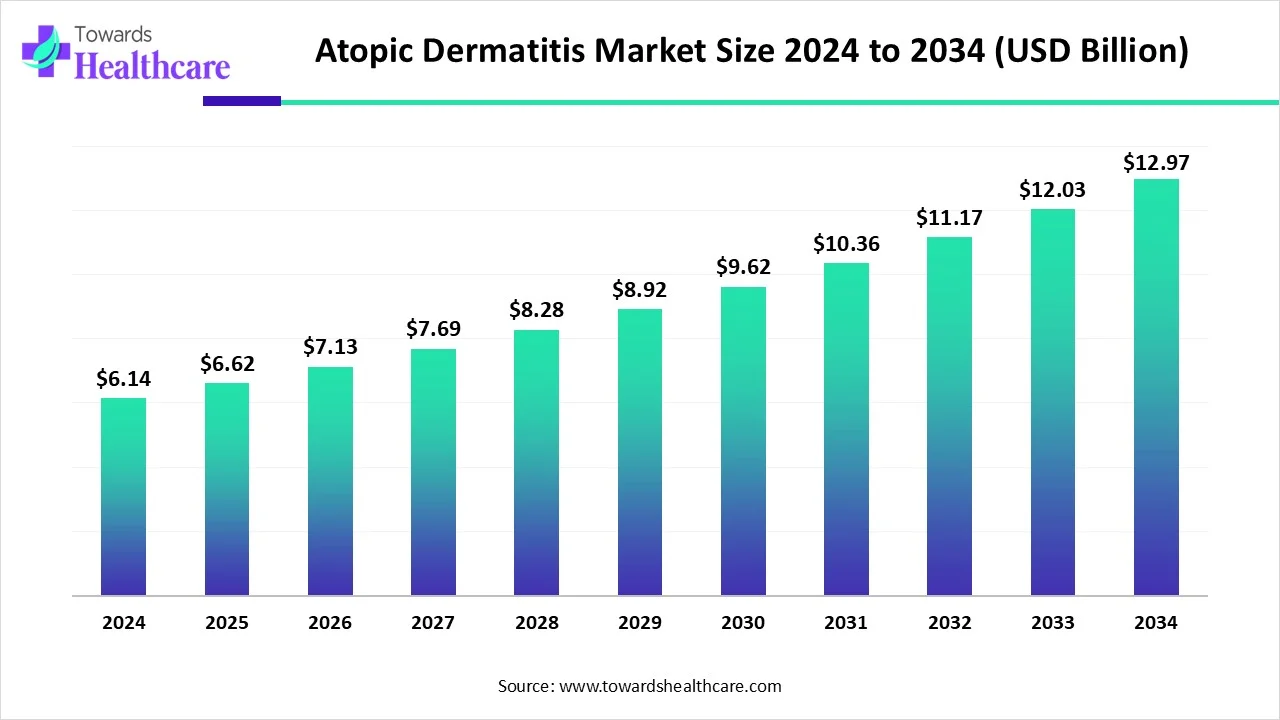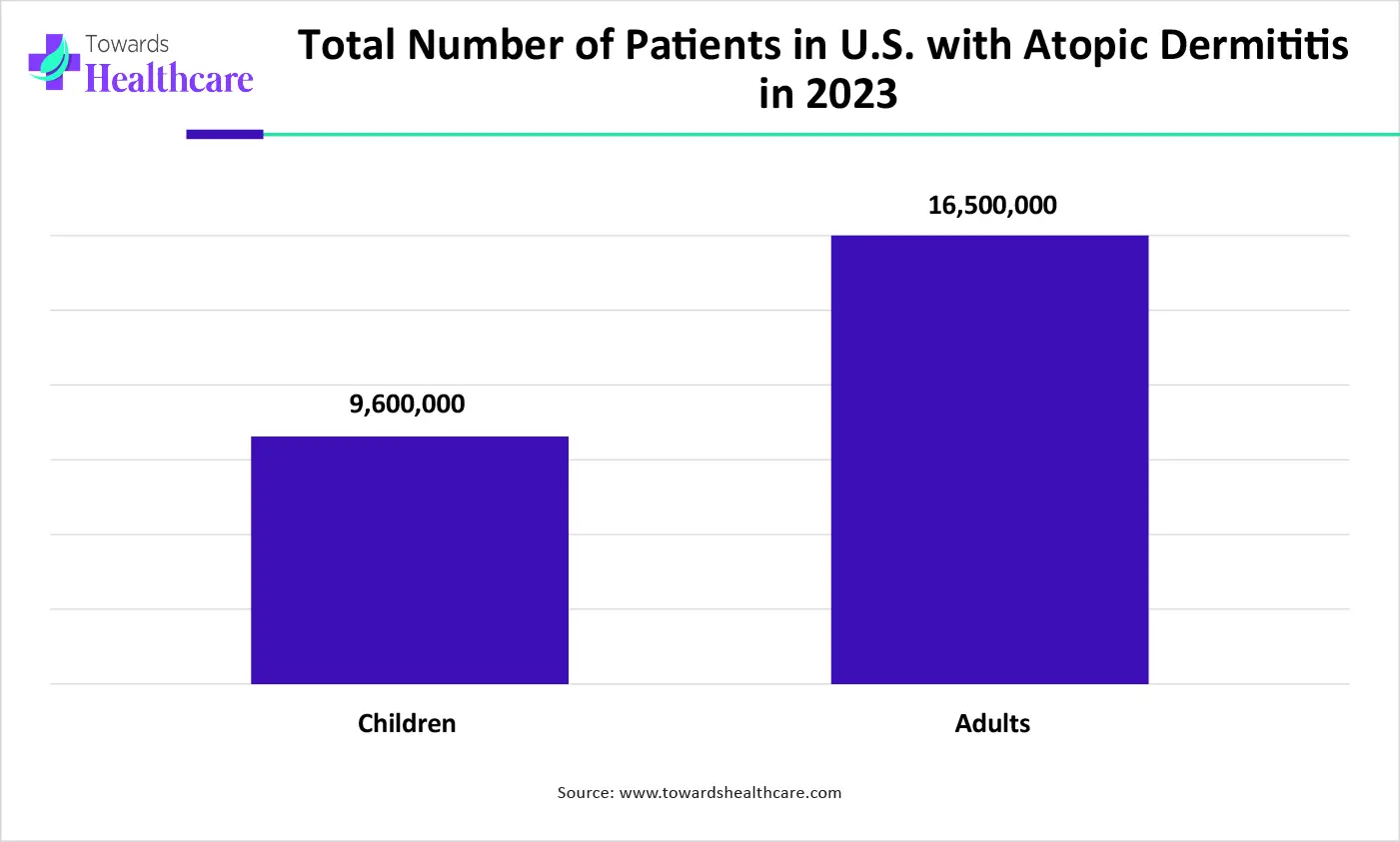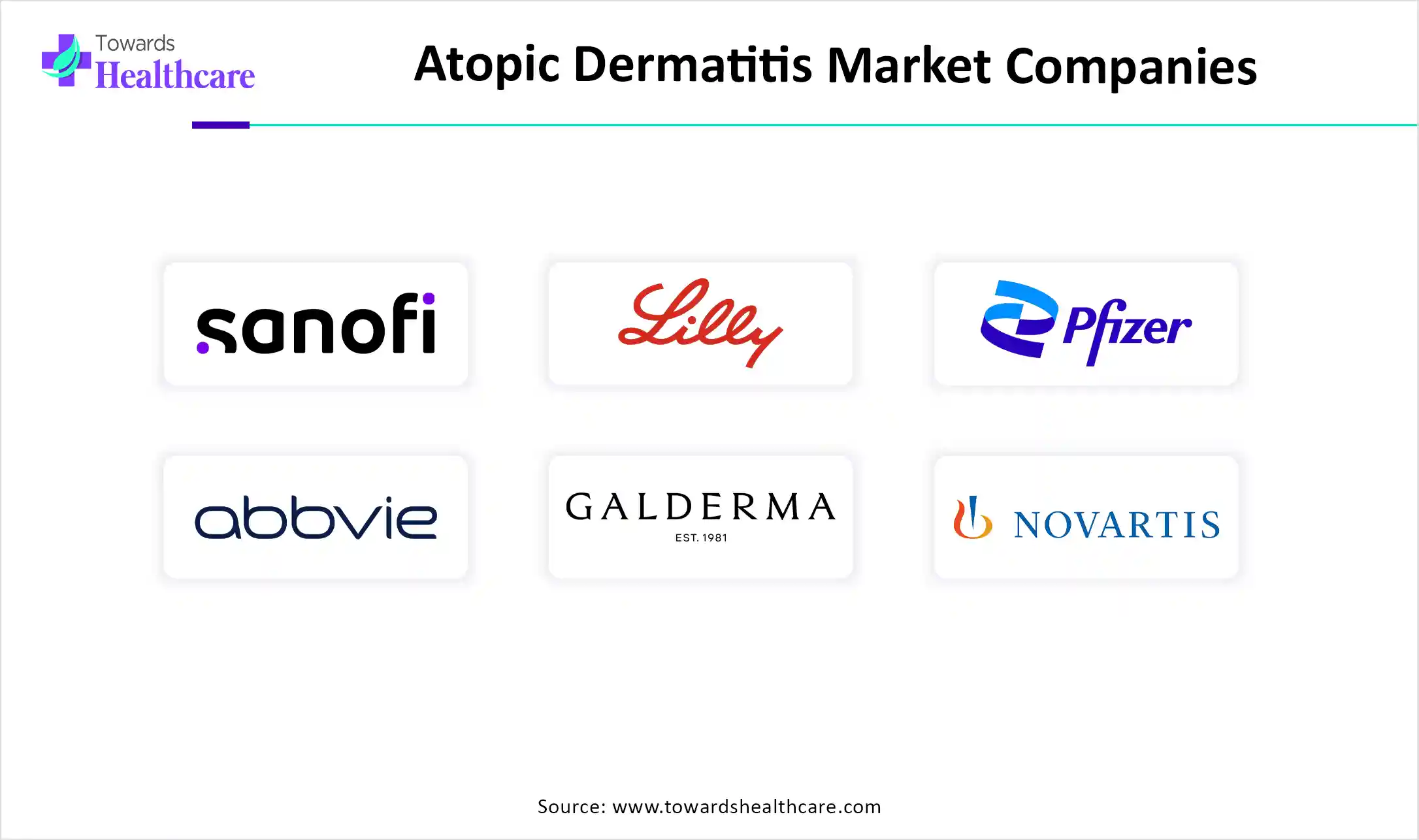November 2025

The global atopic dermatitis market size is calculated at USD 6.14 in 2024, grew to USD 6.62 billion in 2025, and is projected to reach around USD 12.97 billion by 2034. The market is expanding at a CAGR of 7.75% between 2025 and 2034.

| Metric | Details |
| Market Size in 2024 | USD 6.14 Billion |
| Projected Market Size in 2034 | USD 12.97 Billion |
| CAGR (2025 - 2034) | 7.75% |
| Leading Region | North America |
| Market Segmentation | By Type, By Treatment Type, By Route of Administration, By Severity, By Region |
| Top Key Players | Sanofi, Eli Lilly, Pfizer, AbbVie, Galderma, Novartis, Dermira, UCB, Boehringer Ingelheim, Almirall, GSK, Amgen, Regeneron Pharmaceuticals, Mylan, AstraZeneca |
An inflammatory skin disorder, characterized by persistent eczematous lesions along with intense itching, is known as Atopic dermatitis (AD). Atopic dermatitis can be associated with various risk factors such as allergic rhinitis, asthma, mental health disorders, and food allergies. It consists of complex pathophysiology and also includes multiple immune pathways. Thus, the use of topical steroids, emollients, and topical calcineurin inhibitors is increasing, as well as systemic immunosuppressants for patients with critical conditions. Furthermore, new therapeutic strategies are being developed to target the steps in the chain of molecular events causing AD.
Various methods for the management, diagnosis, and treatment of AD have been introduced utilizing artificial intelligence (AI). Recognition of skin images and effective differentiation of different skin lesion types can be carried out using AI algorithms with deep learning techniques. It can also be used to streamline the drug development processes, clinical trials, and the development of personalized treatment plans. These innovative applications can improve the benefits of diagnosis, treatment monitoring, and patient care. Thus, by using AI, precision medicine can be effectively developed, along with enhancing patient outcomes.
Increasing Incidences
The increasing occurrences of atopic dermatitis have increased the demand for its effective management. This is due to increasing population, pollution, as well as changes in lifestyles. Furthermore, due to AD recurrences and complexities associated with it, the need for treatments is rising. Thus, various medications are being made available by the hospitals. Furthermore, various industries are also developing new diagnostic and treatment options along with personalized medications. Similarly, various awareness campaigns are also being conducted for the early detection of AD. Thus, all these factors drive the atopic dermatitis market growth.

The graph represents the total number of patients with atopic dermatitis observed in the U.S. in year of 2023. It indicates that there is a rise in cases of AD in adults. Hence, it increases the demand for new diagnostic and treatment options for the effective management of atopic dermatitis. Thus, this in turn will ultimately promote the market growth.
Recurrence of AD
In most cases, the AD is seen to recur even after the treatment, which in turn can increase the complexities associated with it. It also increases drug resistance, which makes the treatment ineffective. Furthermore, it also contributes to the rising hospital visits as well as the cost associated with them. This causes dissatisfaction among the patients, decreasing treatment adherence. Thus, the demand for new and effective treatments increases.
Rising Treatment Approaches
Various new treatment options are being developed for the effective management of atopic dermatitis. New personalized treatment approaches, depending upon the patient's condition, age, and other related factors, are being developed to improve the patient’s condition. At the same time, new targeted treatments are also being developed by the industries that can minimize the side effects, increasing the adherence to the treatment. Thus, all these factors increase the patient outcome, which in turn promotes the atopic dermatitis market growth.
For instance,
By type, the chronic atopic dermatitis segment dominated the market in 2024. The segmental growth is attributed to the rising prevalence of chronic dermatitis and the growing need for a better quality of life for individuals. A long-term treatment was required for treating the chronic atopic dermatitis, which is a persistent condition. This also increased the demand for new treatment options, contributing to the atopic dermatitis market growth.
By type, the acute atopic dermatitis segment is estimated to grow significantly at a notable CAGR during the forecast period. Due to the growing population, lifestyle changes, and pollution, as well as increasing awareness, early diagnosis and treatment of acute atopic dermatitis are improving.
By treatment type, the topical corticosteroids segment dominated the market in 2024. This segment dominated due to its targeted action and the reduced risk of systemic side effects. The topical corticosteroids were the preferred treatment option for AD. Furthermore, the fast onset of action increased their use, enhancing the patient's adherence to the treatment.
By treatment type, the biologics segment is anticipated to be the fastest-growing during the forecast period. The biologics provide target-specific action, reducing the side effects. This, in turn, increases their use in the chronic atopic dermatitis.
By administration type, the topical segment dominated the market in 2024. The topical route of administration was the ideal choice of treatment as it was directly applied to the affected area. Furthermore, their availability also enhanced the market growth.
By administration type, the systemic segment is expected to grow significantly during the forecast period. The use of the systemic route of administration is rising in the severe cases of AD. Moreover, they are also being used to treat chronic conditions as well as for targeted treatments.
By severity, the severe segment dominated the global atopic dermatitis market in 2024. This segment dominated because of the rising prevalence of severe atopic dermatitis and the need for urgent care. The severe cases of AD required long-term treatment, which increased the demand for new treatment options. Additionally, the industries were also involved in the development of new treatment and diagnostic approaches. This promoted the market growth.
By severity, the mild segment is predicted to grow significantly during the forecast period. The increasing awareness is increasing the early diagnosis of AD. This, in turn, is raising the diagnosis of mild AD, contributing to increased use of medications for its treatment.
North America dominated the atopic dermatitis market in 2024. The healthcare sectors in North America are well developed, along with the presence of specialized staff. This increased the effective diagnosis and treatment of patients with AD, contributing to the market growth.
The presence of advanced healthcare sectors in the U.S. has increased the effective management of AD. At the same time, the diagnosis and treatment options provided to the patients are improving patient outcomes due to the presence of specialized staff.
Canada consists of well-established healthcare sectors that offer various screening and treatment approaches. Furthermore, various companies are also collaborating to develop new such strategies while increasing the production of existing treatment options.
Europe is expected to grow significantly in the atopic dermatitis market during the forecast period. Due to increasing occurrences of atopic dermatitis, Europe is facing a rise in the demand for diagnosis and treatment options. These demands are further supported by the government and regulatory agencies for the effective management of AD, enhancing the market growth.
For instance,
The hospitals in Germany are increasing the demand for various diagnoses and treatment options for the management of rising AD cases and their complications. At the same time, the industries are developing new treatment approaches, which are funded by the government.
Due to the growing incidence of AD, the demand for its management is rising. Thus, various industries in the UK are focused on the development of new strategies for the effective management of AD. Along with the government, the regulatory agencies are also supporting these developments.
Asia Pacific is estimated to host the fastest-growing atopic dermatitis market during the forecast period. The growing population in the Asia Pacific is driving the demand for the treatment and screening of AD. Furthermore, the government is offering its support for making the treatments affordable, which in turn, promotes the market growth.
The growing population in China is increasing the number of patients affected with AD, increasing the demand for treatment options. Hence, the technological advancements and specialized personnel, along with the schemes provided by the government, are improving patient outcomes.
As the population increases, the number of patients infected by AD also increases. This, in turn, increases the demand for treatment and diagnostic options. Thus, various industries are developing new strategies which is supported by the government to make them affordable.
Latin America is considered to be a significantly growing area, due to the rising prevalence of skin disorders and growing research and development activities. The rising adoption of advanced technologies in dermatology clinics enables healthcare professionals to provide advanced treatment to patients. The increasing number of dermal clinics and dermatologists also contributes to market growth. The burgeoning medical tourism encourages patients from North America to travel to Latin America for the treatment of atopic dermatitis.
Brazil accounts for the highest prevalence of atopic dermatitis in Latin America, affecting people of all ages, accounting for 20.1% of the total population. (Source: NIH) In 2024, approximately 11,400 licensed dermatologists were reported in Brazil.
The Atopic Dermatitis Guidelines for Mexico (GUIDAMEX) was formed for the endorsement and participation of ten national medical societies. This improves treatment regimens for patients with atopic dermatitis and creates awareness of early diagnosis and treatment of atopic dermatitis.

By Type
By Treatment Type
By Route of Administration
By Severity
By Region
November 2025
November 2025
November 2025
November 2025